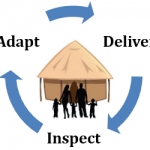When you’re Agile, you’re nimble. You’re flexible and can adapt quickly.
Companies will often need to adapt to sudden change. They should be capable of boosting efficiency, productivity and innovation. Adopting the Agile approach can help any organization do this.
Agile is a popular methodology in industries such as information technology, manufacturing, supply chain management and risk management. One thing these industries all have in common is a human resources department. But, HR is one area where Agile has yet to make its presence known.
However, Agile methods could certainly improve the efficiency of human resources. In fact, one of the basic tenets of the Agile approach is “individuals and interactions over processes and tools.” Therefore, Agile is a people-centric methodology.
And which department knows more about people than HR? According to the Agile manifesto, adopting an Agile approach will make organizational structures simpler and better. This means that implementing Agile in HR should lead to overall improvements, while maintaining a positive relationship with the most important part of any company—its employees. Furthermore, adopting an Agile approach should result in adaptability, teamwork, innovation and swiftness. This may sound of track from your idea of what a human resources department should do, but the HR department is the department that sets standards, monitors performance and supports employees.
Agile in HR is not about creating a one-track, standardized method. A single, rigid approach often proves to be quite inefficient. Instead, Agile should be looked at as a business strategy with various channels leading to talent management solutions based on the changing business environment. HR leaders should simulate different business situations (both good and bad) and figure out strategies to handle each of them effectively. This will enable the HR department to adjust to rapid changes, making the HR team proficient in well-planned agility!
In the everyday work place, HR team members can assist in various ways.
Training: HR professionals should be coaches and leaders, not managers.
Designing: The entire organization is compartmentalized into target-oriented, high performance groups, each with their own functions and goals.
Mission: The HR team delivers a focused and motivating mission statement backed by strong values. The entire organization must be united to reach a common goal.
Transparency: The HR team is responsible for creating a system of transparency throughout the company. Nothing should be hidden, including the company’s goals and finances and individual roles and responsibilities.
Active engagement versus mechanical bookkeeping: The HR team should emphasize engaging teams and employees and recording the effects of such approaches at an organizational level instead of passively recording employee data at irregular intervals.
Constant improvement: The HR team should focus on building a strong culture of learning at all levels of the company. Continuous training, workshops or other professional development activities should form a part of the company’s culture.
Brand creation: For high-quality talent acquisition, the HR team should focus on building a powerful brand in terms of employment. The brand should highlight the positive features of the company from the employee’s point of view. This will attract the “right candidates” to the company.
Honest and positive feedback: The HR team should encourage the exchange of healthy feedback, which encourages the growth of the organization and alleviates problems and process bottlenecks.
R & R programs: From time to time, the HR team should organize programs that serve as a platform to recognize and reward deserving teams and employees to boost their morale.
Let’s not forget one of the easiest ways the HR team can help the organization as a whole become more Agile—hire people who are responsive to change. Hire new employees who are flexible, adaptable and who are ready to grow with the organization.
In this way, companies can adopt the Agile methodology from the inside out.








